
In this issue:
The Hudson River Estuary Action Agenda 2021-2025 sets forth targets to protect the remarkable biodiversity of the Hudson River watershed through conservation of significant natural areas and wildlife habitat. In collaboration with Cornell University, the Conservation and Land Use team of DEC’s Estuary Program works to achieve this by helping partners and municipalities to create plans and policies that incorporate current scientific information, conservation principles, and local and regional biodiversity priorities. Much of our success is due to collaboration with communities, land trusts, and conservation partners from across the estuary watershed. To learn how to get involved, visit Conservation Planning in the Hudson River Estuary Watershed.
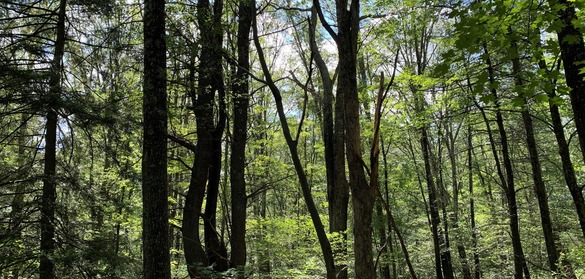 Forest habitat in the Esopus/Lloyd Wetlands and Ridges significant biodiversity area. Photo by L. Heady
There are many complex layers to conservation and land use in the Hudson estuary watershed, including ecological systems that span political and property boundaries, and thousands of individual and local government decision-makers. As communities create plans and policies to address their local needs, many are also grappling with the broader issues of a changing climate, threats to biodiversity, and a housing crisis. To rise to these challenges, strong partnerships and continued learning are essential. And, while we plan for the region’s future, we cannot forget the history of Indigenous peoples who lived here for millennia and called the Hudson River “Muhheakantuck.”
- Conservation and Land Use Team staff attended the Northeastern North America / Turtle Island Landscape Connectivity Summit in Montreal, the first-ever transboundary gathering of different cultures and sectors with a focus on building relationships and charting a path toward an ecologically and culturally connected landscape for all inhabitants.
- Closer to home, we continued dialogue and planning for habitat connectivity in the watershed by convening our annual meeting of the Hudson Valley Conservation Partners group, which includes land trusts, academic institutions, and state agencies like the NYS Department of Transportation.
- We participated in the Berkshire-Taconic Regional Conservation Partnership and the Region 3 Advisory Committee meetings for the NYS Open Space Conservation Plan update.
- We engaged with the Hudson Valley Alliance for Housing and Conservation—a collaboration of land trusts and affordable housing organizations conserving critical landscapes and responding to the region’s housing crisis—and look forward to contributing to the innovative effort next year.
- We invited the Neighbors of the Onondaga Nation (NOON) to bring their Witness to Injustice program to the Hudson Valley, to help our staff and municipal and conservation partners deepen our collective understanding of Indigenous people’s history.
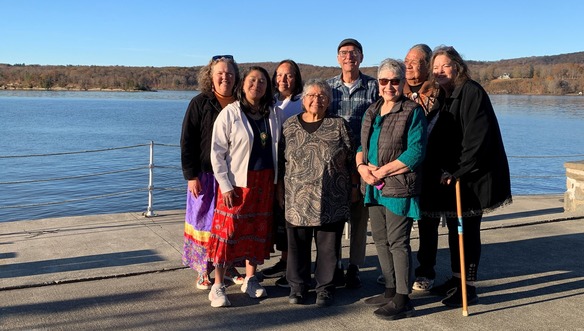 NOON and Haudenosaunee facilitators at Norrie Point in Staatsburg, NY for the Witness to Injustice program in November. Photo by L. Heady
When communities undergo the process of inventorying and mapping natural areas like forests, streams, and important wildlife habitats, they are better positioned to identify local priorities and strategies to protect places they care about, while also contributing to conservation of regional biodiversity.
This year, with grant and technical support from the Estuary Program, the towns of Kent (Putnam County); Clinton, Milan, and Washington (Dutchess County); and New Scotland (Albany County) finalized and adopted their natural resource inventories (NRIs), and Dutchess County launched an NRI website and interactive mapper. In addition to guiding land-use planning, conservation, and stewardship for individuals, municipal officials, and watershed groups, the NRIs can support a place-based learning approach for students, educators, and the public.
The City of Rensselaer (Rensselaer County) adopted an Open Space and Recreation Plan (PDF) with funding from an Estuary Grant. The project evaluated the ways in which parks and open spaces support climate resiliency and recreation for city residents.
These projects contribute to our Action Agenda target of 25 new or updated conservation practices, plans, or policies completed by 2025, and our target of 40% of municipalities using their NRIs for a conservation plan or policy. Since 2015, we’ve assisted 51 communities with creating NRIs and 37% percent have used these to implement plans or policies.
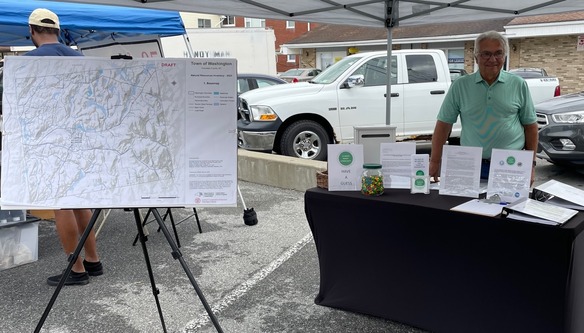 Volunteers tabled to educate residents about the Washington and Millbrook NRI project at local events. Photo by M. Schneible
For municipalities interested in implementing their open space and conservation plans, securing funds is an important next step. This year, the City of Kingston successfully established a community preservation fund (CPF) through public referendum. The CPF will establish a dedicated account to preserve natural areas, recreational lands, clean water, and other community priorities identified in the city’s community preservation plan (CPP). The Estuary Program provided assistance and grants to support Kingston’s planning process, including a natural resources inventory, open space plan, and the recent CPP. As Kingston joins the growing group of municipalities pursuing CPF as a conservation financing option, it contributes to our Action Agenda target to help five watershed municipalities establish local land acquisition programs to advance their conservation priorities by 2030.
Our research collaborators at the Department of Natural Resources and the Environment (DNRE) at Cornell University released a new publication this year. Natural Resources Protection in the Hudson Valley: Municipal Conservation Stories (PDF) illustrates the important contributions and dedication that local municipalities bring to conservation and land-use planning in the estuary watershed. The publication presents case studies from seven watershed towns and highlights the experiences, challenges, and success of elected officials and municipal volunteers in pursuing conservation actions.
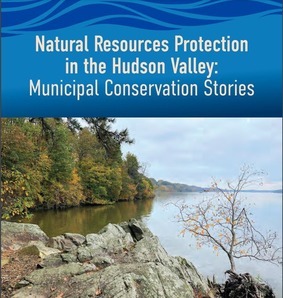 |
Municipal Conservation Stories was funded by a grant from the NYS Water Resources Institute and evolved from a collaborative project with Cornell DNRE researchers and the Conservation and Land Use Team at the Estuary Program. A key component of the project was the development of a Municipal Conservation Efforts Index, which scored 256 watershed municipalities based on a set of 19 possible actions that support conservation. The index included a range of local practices, plans, and policies, such as adopting stream buffer protection, creating an open space plan, or having a conservation advisory council. Municipal officials and volunteers from communities with high or medium index scores gave interviews about their experiences with specific plans and policies, sharing lessons learned and recommendations.
The authors hope the publication will shed light on both successes and challenges of conservation planning, and support and inform the work of practitioners, volunteers, and local governments throughout New York State.
Our training programs placed special emphasis on wetlands and streams this year. These aquatic resources are critical components of watersheds, provide habitat, and contribute to the climate resiliency and well-being of our communities.
In partnership with Hudsonia Ltd., we offered four outdoor workshops focused on identifying and protecting small streams and wetlands, which are often overlooked and undervalued. The 61 attendees joined us from nine counties in the estuary watershed, representing municipal boards and committees; county and state agencies; and land trusts. Participants were guided to a variety of streams and wetlands such as vernal pools, intermittent streams, and swamps, to discuss their different characteristics and values, state and federal regulatory protections, and opportunities for landowners and municipalities to proactively conserve these important features.
Our Conservation and Land Use Webinar Series featured two webinars with presentations from DEC colleagues on the state’s multiphase process to develop new freshwater wetland regulations. More than 1,100 participants took part in these opportunities to learn about the proposed changes. Visit the Conservation and Land Use Webinars webpage to view recordings of these and other webinars.
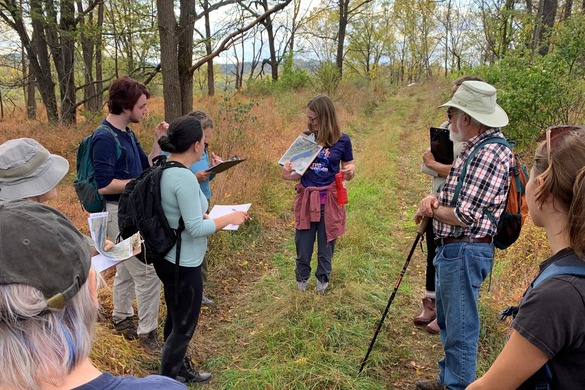 Conservation and Land Use Specialist Christine Vanderlan (center) with participants of a small streams and wetlands workshop in Orange County. Photo by L. Heady
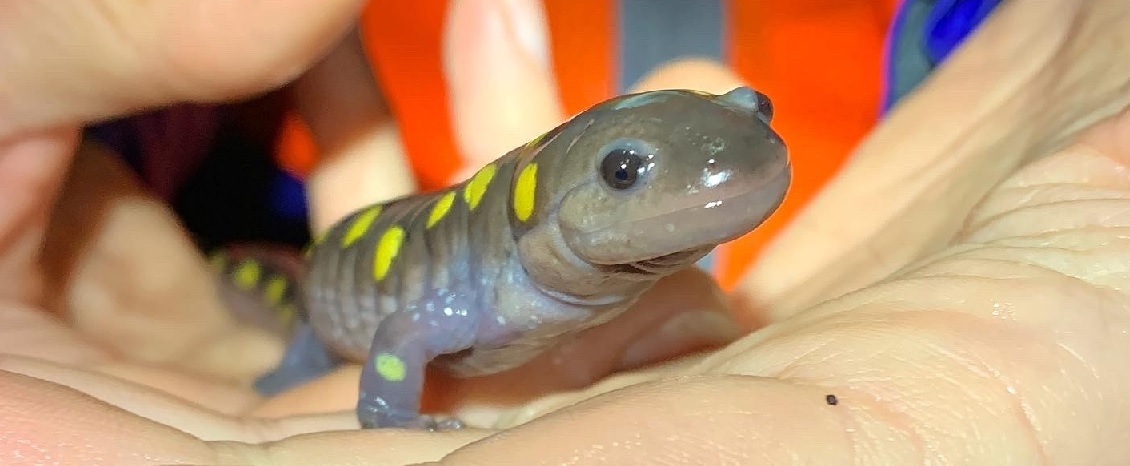 Spotted salamander. Photo by M. McDonald
More than 350 people participated in the 16th year of the Amphibian Migrations & Road Crossings Project (AM&RC). These stellar volunteers collected data on rainy nights when temperatures remained above 40F, which, if the ground is thawed, provide the perfect conditions to spur the breeding migrations of forest amphibians to vernal pools. These migrations were once considered a rite of spring, but with milder winters, have started earlier. This year, amphibians were on the move throughout the estuary watershed in late February.
AM&RC volunteers survey locations where migration pathways cross roads and, after documenting their observations, help move the salamanders and frogs safely to the other side. This year, they counted more than 7,500 live and 4,670 dead amphibians and assisted 7,025 individuals, including spotted salamander, Jefferson-blue spotted salamander complex, four-toed salamander, and wood frog. DEC’s Facebook Live captured the rainy action in Ulster County on March 6: Part 1 and Part 2. Many thanks to the volunteers and AM&RC Project Partners who contributed to another successful and safe season!
|